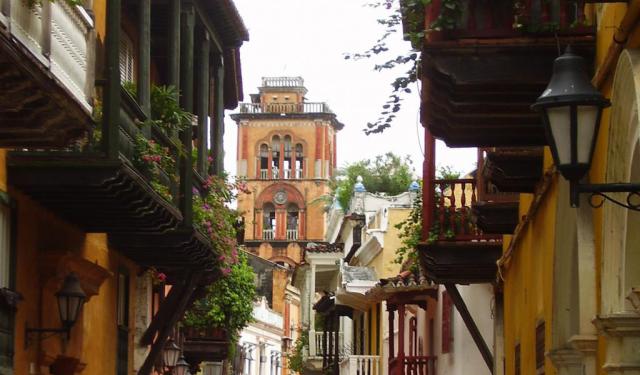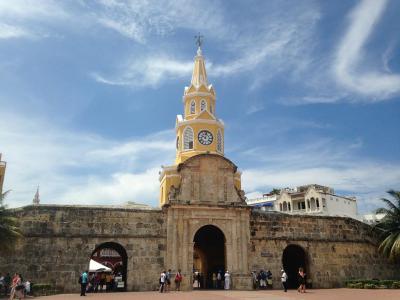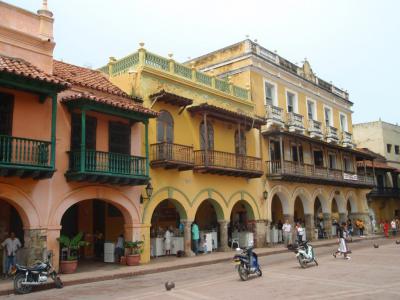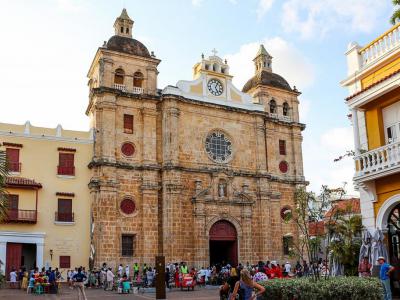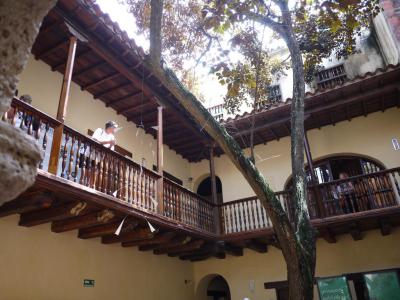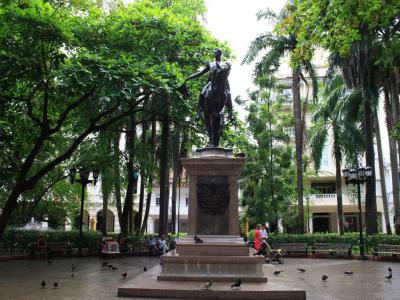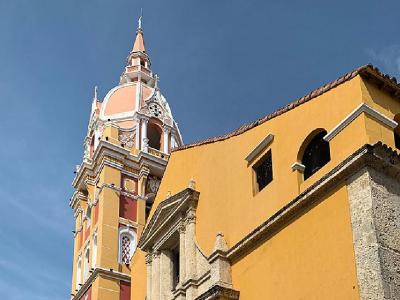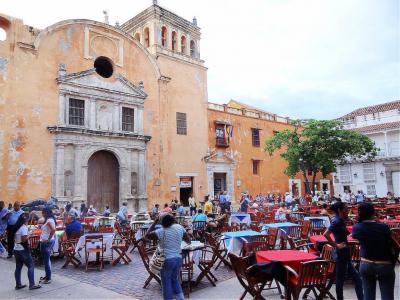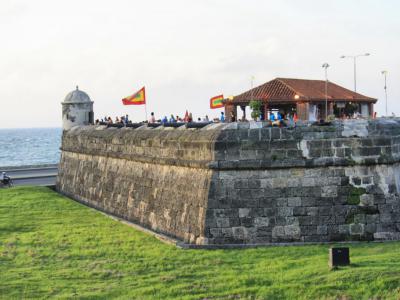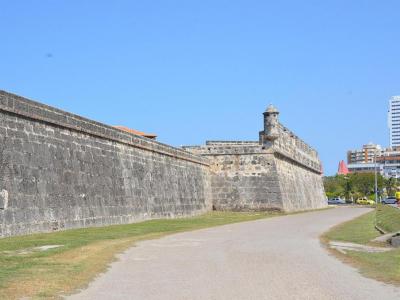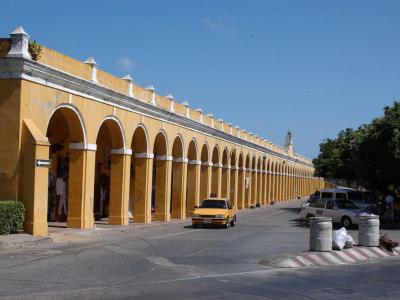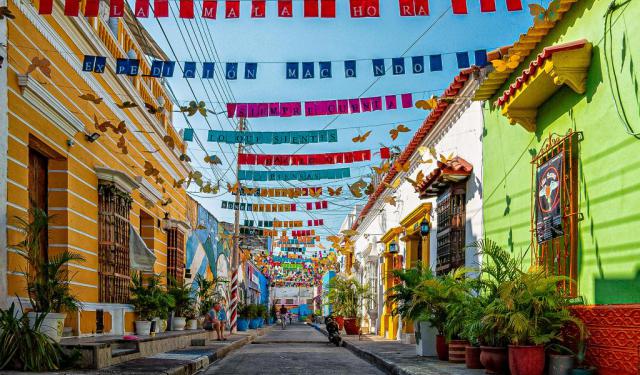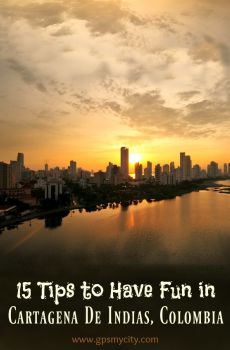Cartagena Introduction Walking Tour (Self Guided), Cartagena
Cartagena is a charming port city situated on the Caribbean coast of Colombia, South America. It was founded in 1533 by Pedro de Heredia, a Spanish conquistador. The city is known in Spanish as "Cartagena of Indies" and is named after the city of Cartagena in Spain.
In the pre-Columbian era, indigenous people became settled in the region. The Puerto Hormiga culture dates back as early as 4000 B.C. and, based on archaeological finds, appears to be the earliest human community to inhabit this locality.
After the plundering of Cartagena during a 1586 battle led by explorer Francis Drake, plans for a city fortification were formulated. Soon, the construction of a bastion and city walls began. The walls surrounded the city and offered protection against future enemy attacks. The bastion, Bastion of Santo Domingo, and the city walls are essential spots to visit during a tour around the city.
A dark past is part of the history of Cartagena. During colonial times, it was the main port of entry for slave ships arriving in Colombia from Africa. Just inside the city walls is Plaza de los Coches, a square that once held Cartagena's slave market. A historical landmark located on this square is Clock Tower, a clock tower and gateway into the Old City.
The walled Old City features a maze of narrow streets, lively squares, tropical foliage, and beautiful Spanish Colonial architecture. There are several magnificent churches to see in this area, including the San Pedro Claver Church and Cartagena Cathedral. Atop Cartagena's highest hill is the must-see La Popa Convent. Its location offers breathtaking views of the city and the Caribbean Sea.
You can't fail to notice the "fruit ladies of Cartagena" as you stroll the city streets. Known as the "Palenqueras," these women wear brightly colored dresses and hold bowls of tropical fruit on their heads. Visitors love getting a photo taken with these popular city icons! Enjoy this self-guided walking tour that takes you on an exploration of the vibrant city of Cartagena.
In the pre-Columbian era, indigenous people became settled in the region. The Puerto Hormiga culture dates back as early as 4000 B.C. and, based on archaeological finds, appears to be the earliest human community to inhabit this locality.
After the plundering of Cartagena during a 1586 battle led by explorer Francis Drake, plans for a city fortification were formulated. Soon, the construction of a bastion and city walls began. The walls surrounded the city and offered protection against future enemy attacks. The bastion, Bastion of Santo Domingo, and the city walls are essential spots to visit during a tour around the city.
A dark past is part of the history of Cartagena. During colonial times, it was the main port of entry for slave ships arriving in Colombia from Africa. Just inside the city walls is Plaza de los Coches, a square that once held Cartagena's slave market. A historical landmark located on this square is Clock Tower, a clock tower and gateway into the Old City.
The walled Old City features a maze of narrow streets, lively squares, tropical foliage, and beautiful Spanish Colonial architecture. There are several magnificent churches to see in this area, including the San Pedro Claver Church and Cartagena Cathedral. Atop Cartagena's highest hill is the must-see La Popa Convent. Its location offers breathtaking views of the city and the Caribbean Sea.
You can't fail to notice the "fruit ladies of Cartagena" as you stroll the city streets. Known as the "Palenqueras," these women wear brightly colored dresses and hold bowls of tropical fruit on their heads. Visitors love getting a photo taken with these popular city icons! Enjoy this self-guided walking tour that takes you on an exploration of the vibrant city of Cartagena.
How it works: Download the app "GPSmyCity: Walks in 1K+ Cities" from Apple App Store or Google Play Store to your mobile phone or tablet. The app turns your mobile device into a personal tour guide and its built-in GPS navigation functions guide you from one tour stop to next. The app works offline, so no data plan is needed when traveling abroad.
Cartagena Introduction Walking Tour Map
Guide Name: Cartagena Introduction Walking Tour
Guide Location: Colombia » Cartagena (See other walking tours in Cartagena)
Guide Type: Self-guided Walking Tour (Sightseeing)
# of Attractions: 10
Tour Duration: 2 Hour(s)
Travel Distance: 2.4 Km or 1.5 Miles
Author: DanaOffice
Sight(s) Featured in This Guide:
Guide Location: Colombia » Cartagena (See other walking tours in Cartagena)
Guide Type: Self-guided Walking Tour (Sightseeing)
# of Attractions: 10
Tour Duration: 2 Hour(s)
Travel Distance: 2.4 Km or 1.5 Miles
Author: DanaOffice
Sight(s) Featured in This Guide:
- Torre del Reloj (Clock Tower)
- Portal de Los Dulces (Sweets Portal)
- Iglesia de San Pedro Claver (St. Peter Claver Church)
- Museo del Oro Zenu (Zenu Gold Museum)
- Plaza de Bolivar (Bolivar Square)
- Catedral de Santa Catalina de Alejandria (Cartagena Cathedral)
- Plaza de Santo Domingo (Santo Domingo Square)
- Baluarte de Santo Domingo (Bastion of Santo Domingo)
- Murallas de Cartagena (Cartagena City Walls)
- Las Bovedas (The Vaults)
1) Torre del Reloj (Clock Tower) (must see)
The main entrance to the historic walled city of Cartagena is famously known as the Clock Tower (Torre del Reloj). This significant landmark, built into the city wall, features a trio of open archways that offer a gateway into the Old City. A stunning clock tower crowns the central arch. With Baroque architecture, this beautiful eight-sided tower is painted golden-yellow with white trim.
Construction of this gateway took place between 1601 and 1631. Initially, only the central archway existed as a portal to the city. It was known as the Mouth of the Bridge (Boca del Puente). The other two housed an armory and a chapel. The clock tower was added later, during the early 18th century.
The Clock Tower is located next to Cars Square (Plaza de Los Coches) just inside the city walls. This triangular-shaped city square has a dark past as the place that once held Cartagena's slave market. This past also included public gallows in the center of the town square. On the plaza, directly across from the clock tower, you'll find the well-liked Cartagena sweets market known as Sweets Portal (Portal de Los Dulces).
The clock tower gate also serves as a connection from the city to the nearby Getsemani neighborhood just outside the walls. Getsemani is now a hip neighborhood filled with graffiti art and brightly painted buildings. Don't miss the two statues of Pegasus located on a nearby road that leads to the outside of the clock tower.
Construction of this gateway took place between 1601 and 1631. Initially, only the central archway existed as a portal to the city. It was known as the Mouth of the Bridge (Boca del Puente). The other two housed an armory and a chapel. The clock tower was added later, during the early 18th century.
The Clock Tower is located next to Cars Square (Plaza de Los Coches) just inside the city walls. This triangular-shaped city square has a dark past as the place that once held Cartagena's slave market. This past also included public gallows in the center of the town square. On the plaza, directly across from the clock tower, you'll find the well-liked Cartagena sweets market known as Sweets Portal (Portal de Los Dulces).
The clock tower gate also serves as a connection from the city to the nearby Getsemani neighborhood just outside the walls. Getsemani is now a hip neighborhood filled with graffiti art and brightly painted buildings. Don't miss the two statues of Pegasus located on a nearby road that leads to the outside of the clock tower.
2) Portal de Los Dulces (Sweets Portal)
In the triangular-shaped Cars Square (Plaza de Los Coches), you'll find a candy market called Sweets Portal (Portal de Los Dulces). This site was named years ago for the sweet pastries sold there by street hagglers. You will find this lively market in the arcaded walkways of a row of old houses. The lovely Spanish colonial architecture of these brightly painted structures, with their charming balconies and tile roofs, is worth checking out.
At this outdoor market, you will find dozens of confectionary stands with vendors selling homemade candies and pastries. Jars filled with a variety of sweet treats are on display. You'll have fun shopping for delicious Caribbean delicacies with an emphasis on coconut sweets. Try the popular Cubanitos, rolled candy wrapped in colored paper.
Enjoy the colorful display of treats and the wonderful aroma of sweets in the air as you stroll through this inviting marketplace. There are also some interesting shops and restaurants around this colonial square. Don't miss Cartagena's landmark clock tower, directly across from the Sweets Portal.
At this outdoor market, you will find dozens of confectionary stands with vendors selling homemade candies and pastries. Jars filled with a variety of sweet treats are on display. You'll have fun shopping for delicious Caribbean delicacies with an emphasis on coconut sweets. Try the popular Cubanitos, rolled candy wrapped in colored paper.
Enjoy the colorful display of treats and the wonderful aroma of sweets in the air as you stroll through this inviting marketplace. There are also some interesting shops and restaurants around this colonial square. Don't miss Cartagena's landmark clock tower, directly across from the Sweets Portal.
3) Iglesia de San Pedro Claver (St. Peter Claver Church) (must see)
The Church of Saint Peter Claver (Iglesia de San Pedro Claver) in the homonymous square (Plaza de San Pedro Claver) forms part of the complex of buildings made up of the Convent of San Pedro Claver and the archaeological museum. The church was built between 1580 and 1654 and was originally known as San Juan de Dios. In 1622, it was re-dedicated to San Ignacio de Loyola, before finally being assigned to San Pedro Claver.
The latter was a Jesuit priest and missionary who dedicated practically all his life to evangelizing the African slaves of New Granada. Born in Spain in 1580, Claver ministered at this church for many years and died at the adjacent convent in 1654. He was declared a saint in 1888.
The church building is of Spanish Colonial design, all except the dome, which was replaced in 1921. The architecture generally corresponds to the style commonly regarded as "Jesuit", widespread throughout Latin America. Much of its monumental façade is made of stone delivered from the island of Tierrabomba. The large and ornate wooden doors at the front, however, deviate from the Baroque style.
In contrast to the Baroque profusion on the outside, the interior of the church is distinguished by its severity. There are some beautiful stained glass windows and a winding staircase, climbing which you can get a bird's eye view of the inside. Underneath the main altar (made of marble imported from Italy), is a glass coffin holding the remains of Saint Peter Claver.
The three-story building of the convent, surrounding a lovely courtyard, is now a museum dedicated to the saint, Colombia's indigenous people, and the history of this location. In addition to the numerous artifacts on display, you can also see the humble dormitory in which San Pedro Claver lived and died.
Don't miss the whimsical metal sculptures in the square outside the church either. These delightfully avant-garde depictions of people at work and play were crafted by Colombian artist Eduardo Carmona. There is also a bronze statue of San Pedro Claver blessing a slave, created by sculptor Enrique Grau.
The latter was a Jesuit priest and missionary who dedicated practically all his life to evangelizing the African slaves of New Granada. Born in Spain in 1580, Claver ministered at this church for many years and died at the adjacent convent in 1654. He was declared a saint in 1888.
The church building is of Spanish Colonial design, all except the dome, which was replaced in 1921. The architecture generally corresponds to the style commonly regarded as "Jesuit", widespread throughout Latin America. Much of its monumental façade is made of stone delivered from the island of Tierrabomba. The large and ornate wooden doors at the front, however, deviate from the Baroque style.
In contrast to the Baroque profusion on the outside, the interior of the church is distinguished by its severity. There are some beautiful stained glass windows and a winding staircase, climbing which you can get a bird's eye view of the inside. Underneath the main altar (made of marble imported from Italy), is a glass coffin holding the remains of Saint Peter Claver.
The three-story building of the convent, surrounding a lovely courtyard, is now a museum dedicated to the saint, Colombia's indigenous people, and the history of this location. In addition to the numerous artifacts on display, you can also see the humble dormitory in which San Pedro Claver lived and died.
Don't miss the whimsical metal sculptures in the square outside the church either. These delightfully avant-garde depictions of people at work and play were crafted by Colombian artist Eduardo Carmona. There is also a bronze statue of San Pedro Claver blessing a slave, created by sculptor Enrique Grau.
4) Museo del Oro Zenu (Zenu Gold Museum)
The Zenú Gold Museum (Museo del Oro Zenu) is a small museum focusing on the Zenú people of Colombia. The Zenú is an ancient indigenous culture that once thrived in the region. The elaborate gold ornaments they created attracted Spanish conquistadors who looted the gold, even participating in grave robbing. The gold eventually led to the downfall of the Zenu.
The museum showcases the goldsmithing expertise of the Zenú people. On exhibit are hundreds of archaeological objects, jewelry, and relics highlighted by many exquisitely crafted pieces in gold. There are also ceramic art objects, pottery, and other Colombian artifacts on display. Some very ornate gold figurines of animals, birds, and other creatures are intriguing.
The Zenú Gold Museum is in a prominent location inside a colonial mansion in Bolivar Square, the main square of the Cartagena old city. Visit this two-story museum and enjoy the marvelous displays. Happily, admission is free.
The museum showcases the goldsmithing expertise of the Zenú people. On exhibit are hundreds of archaeological objects, jewelry, and relics highlighted by many exquisitely crafted pieces in gold. There are also ceramic art objects, pottery, and other Colombian artifacts on display. Some very ornate gold figurines of animals, birds, and other creatures are intriguing.
The Zenú Gold Museum is in a prominent location inside a colonial mansion in Bolivar Square, the main square of the Cartagena old city. Visit this two-story museum and enjoy the marvelous displays. Happily, admission is free.
5) Plaza de Bolivar (Bolivar Square)
In the heart of the old walled city of Cartagena, you'll find Bolivar Square (Plaza de Bolivar). Inside this lovely square is a park full of lush greenery, shady trees, fountains, and plenty of benches that are perfect for relaxing on a sunny day. With its central location, it is considered the main square of the city.
In the center of the square is an equestrian statue of Simon Bolivar, the first president of Colombia, who was famously known as "The Liberator." The bronze statue rests on a granite pedestal and has had a prominent place in the square since 1896. It was created by Venezuelan artist and sculptor Eloy Palacios.
Around Bolivar Square are some lovely historic buildings stylized with features that include arcaded walkways, balconies, and tiled roofs. At one corner, you'll find the impressive Cartagena Cathedral. You will also find several intriguing museums around this square and nearby. Museums include the Palace of the Inquisition, the Zenu Gold Museum, and the Emerald Museum inside Caribe Jewelry.
Bolivar Square offers a shady tropical oasis in the center of Cartagena. You won't want to miss an exploration of this charming historical place.
In the center of the square is an equestrian statue of Simon Bolivar, the first president of Colombia, who was famously known as "The Liberator." The bronze statue rests on a granite pedestal and has had a prominent place in the square since 1896. It was created by Venezuelan artist and sculptor Eloy Palacios.
Around Bolivar Square are some lovely historic buildings stylized with features that include arcaded walkways, balconies, and tiled roofs. At one corner, you'll find the impressive Cartagena Cathedral. You will also find several intriguing museums around this square and nearby. Museums include the Palace of the Inquisition, the Zenu Gold Museum, and the Emerald Museum inside Caribe Jewelry.
Bolivar Square offers a shady tropical oasis in the center of Cartagena. You won't want to miss an exploration of this charming historical place.
6) Catedral de Santa Catalina de Alejandria (Cartagena Cathedral)
Sitting on the corner of the lively Bolivar Square in Cartagena is the magnificent church of Spanish Renaissance style, brightly painted in lemon-yellow with a white trim. The bell tower and dome rising over the rooftops of the Old City make it really hard to miss this architectural landmark.
The temple, officially known as the Metropolitan Cathedral Basilica of Santa Catalina of Alexandria, is the episcopal see of the Archbishop of Cartagena de Indias (one of the oldest episcopal sees in the Americas), and it is dedicated to the Christian martyr, Santa Catalina (aka Saint Catherine) of Alexandria.
The cathedral was built between 1577 and 1612, replacing a modest church of wood and reeds on this site. In 1586, while still under construction, the building suffered severe damage which seriously delayed its completion when Cartagena came under attack by the English privateer (pirate) Francis Drake. Armed with a fleet of up to 23 warships and more than 3,000 men, Drake captured the city and looted it for six weeks, threatening to destroy the cathedral, unless a juicy ransom was paid.
The first warning shot that he fired on the structure struck one of the columns, knocking it down and taking two more with it. The four arches supported by the columns and part of the roof also collapsed as a result. Finally, the Cartagenians agreed to pay “El Draque” 110,000 silver ducats to stop the destruction.
The original structure of the cathedral has been preserved to this day almost unchanged. Designed by master builder Simón González, it was modeled on basilicas in Andalusia, Spain and the Canary Islands. Later, in 1908, the tower and the dome of the cathedral were refurbished, but the balconies, the main portal, and the cornices are original from the colonial era.
The interior includes three naves divided by columned archways. The gilded high altar is large and exquisite, featuring small statuary and ornate gold decorations. High up on the side walls, there are nicely carved wooden reliefs depicting religious scenes. Also noteworthy is the gorgeous marble flooring of checkered tiles in shades of black and white.
Outside, in Plaza de la Proclamación (Proclamation Square), you can see a bronze statue of Pope John Paul II, a monument to the papal visit in 1986.
The temple, officially known as the Metropolitan Cathedral Basilica of Santa Catalina of Alexandria, is the episcopal see of the Archbishop of Cartagena de Indias (one of the oldest episcopal sees in the Americas), and it is dedicated to the Christian martyr, Santa Catalina (aka Saint Catherine) of Alexandria.
The cathedral was built between 1577 and 1612, replacing a modest church of wood and reeds on this site. In 1586, while still under construction, the building suffered severe damage which seriously delayed its completion when Cartagena came under attack by the English privateer (pirate) Francis Drake. Armed with a fleet of up to 23 warships and more than 3,000 men, Drake captured the city and looted it for six weeks, threatening to destroy the cathedral, unless a juicy ransom was paid.
The first warning shot that he fired on the structure struck one of the columns, knocking it down and taking two more with it. The four arches supported by the columns and part of the roof also collapsed as a result. Finally, the Cartagenians agreed to pay “El Draque” 110,000 silver ducats to stop the destruction.
The original structure of the cathedral has been preserved to this day almost unchanged. Designed by master builder Simón González, it was modeled on basilicas in Andalusia, Spain and the Canary Islands. Later, in 1908, the tower and the dome of the cathedral were refurbished, but the balconies, the main portal, and the cornices are original from the colonial era.
The interior includes three naves divided by columned archways. The gilded high altar is large and exquisite, featuring small statuary and ornate gold decorations. High up on the side walls, there are nicely carved wooden reliefs depicting religious scenes. Also noteworthy is the gorgeous marble flooring of checkered tiles in shades of black and white.
Outside, in Plaza de la Proclamación (Proclamation Square), you can see a bronze statue of Pope John Paul II, a monument to the papal visit in 1986.
7) Plaza de Santo Domingo (Santo Domingo Square) (must see)
Plaza de Santo Domingo (Santo Domingo Square) is a vibrant square in the Old City of Cartagena. It was named after the beautiful church and convent Santo Domingo Church (also known as Santo Domingo Convent), which stands on one of its corners. The orange-yellow facade of the church and its massive arched entryway is striking. Check out the twisted bell tower on top.
With a gruesome past, this square was used during the Spanish Inquisition as a place for executions. The buildings surrounding Santo Domino Square boast Spanish Colonial architecture featuring balconies and red tile roofs. Around the square are shops, street vendors, lively restaurants, and plenty of outdoor tables for dining and relaxing.
Don't miss the famous "La Gorda Gertrudis" (Fat Gertrudis), a statue of a naked Rubenesque woman done in bronze. The sculpture was created by renowned artist Fernando Botero and stands in front of the church. It is a popular spot for taking photographs. The narrow nearby alleyways that branch off Santo Domingo Square are just ripe for exploration!
With a gruesome past, this square was used during the Spanish Inquisition as a place for executions. The buildings surrounding Santo Domino Square boast Spanish Colonial architecture featuring balconies and red tile roofs. Around the square are shops, street vendors, lively restaurants, and plenty of outdoor tables for dining and relaxing.
Don't miss the famous "La Gorda Gertrudis" (Fat Gertrudis), a statue of a naked Rubenesque woman done in bronze. The sculpture was created by renowned artist Fernando Botero and stands in front of the church. It is a popular spot for taking photographs. The narrow nearby alleyways that branch off Santo Domingo Square are just ripe for exploration!
8) Baluarte de Santo Domingo (Bastion of Santo Domingo)
The Bastion of Santo Domingo (Baluarte de Santo Domingo) is a fortification, the origin of the Cartagena city walls constructed to protect the town against attacks. Soon after explorer Francis Drake pillaged Cartagena in 1586, plans were made to create a bastion to secure access to the city.
There are several things to see during your exploration of this large fortification. The stonework and masonry walls are well preserved. On the top of the bastion are rows of iron cannons resting along the parapet. At the front corner of the triangular-shaped structure is a small stone turret used as a watch tower.
This structure is located right next to the harbor and offers breathtaking panoramic views of the city skyline and the Caribbean Sea. Cafe del Mar, a lively restaurant and bar with plenty of outdoor tables, has a central location on top of the bastion. It's a fun spot to stop and take in the magnificent views, enjoy a drink, listen to music, and watch the sunset.
There are several things to see during your exploration of this large fortification. The stonework and masonry walls are well preserved. On the top of the bastion are rows of iron cannons resting along the parapet. At the front corner of the triangular-shaped structure is a small stone turret used as a watch tower.
This structure is located right next to the harbor and offers breathtaking panoramic views of the city skyline and the Caribbean Sea. Cafe del Mar, a lively restaurant and bar with plenty of outdoor tables, has a central location on top of the bastion. It's a fun spot to stop and take in the magnificent views, enjoy a drink, listen to music, and watch the sunset.
9) Murallas de Cartagena (Cartagena City Walls) (must see)
The walls around the Old City of Cartagena were built as protection against enemy attacks and pirate raids. The city walls reached completion in 1796 after nearly two centuries of construction. The wall is thick and well-constructed. Today, the walls represent one of the best-preserved fortifications in South America.
Walking along the Murallas de Cartagena (Cartagena City Walls) is a fun way to explore the walled site and offers fabulous views of the city and the glistening Caribbean Sea. The walls surround the historic Old Cartagena and stretch for 11 kilometers (just under seven miles). In spots along the wall, you'll find watch towers, old iron cannons, and lookout points.
A popular place to watch the sunset is from the Bastion of Santo Domingo, a fortification that marks the origin of the efforts to secure the city. Cafe del Mar is a restaurant with a central spot at the top of the bastion along the city walls. Relaxing on the walls and enjoying a drink is a great way to end a day exploring Cartagena.
Walking along the Murallas de Cartagena (Cartagena City Walls) is a fun way to explore the walled site and offers fabulous views of the city and the glistening Caribbean Sea. The walls surround the historic Old Cartagena and stretch for 11 kilometers (just under seven miles). In spots along the wall, you'll find watch towers, old iron cannons, and lookout points.
A popular place to watch the sunset is from the Bastion of Santo Domingo, a fortification that marks the origin of the efforts to secure the city. Cafe del Mar is a restaurant with a central spot at the top of the bastion along the city walls. Relaxing on the walls and enjoying a drink is a great way to end a day exploring Cartagena.
10) Las Bovedas (The Vaults)
Exploring the Old City of Cartagena one cannot miss the immense arcade of columns and arches of bright golden color, located between the forts of Santa Clara and Santa Catalina. Known as Las Bóvedas (The Vaults), this building is indeed massive. Its walls – 15 meters thick(!) – were originally intended to protect a military storehouse.
The 23 bombproof arcades were built between 1789 and 1795 to a design by Antonio de Arebalo, a military engineer who worked on all fortifications in Cartagena. The 47 porticos were added in 1798. For a while, the vaults were used by the Spanish Crown as a garrison, the same purpose later used by republican forces. During the civil wars in the 19th century, the vaults were utilized as prison cells; at high tide, the unfortunate inmates had to stand up to their knees in seawater.
Nowadays, the building has become a lively marketplace, with the dungeon cells accommodating boutiques and other businesses. Inside the numbered vaults shops are selling a vast array of souvenirs: handcrafted items, paintings, colorful clothing, jewelry, and more. Together with the breathtaking view of the Caribbean Sea, this makes Las Bóvedas a popular tourist destination, appealing to those who love to stroll along the arcaded walkway whilst exploring traditional Colombian merchandise in this historic landmark.
The 23 bombproof arcades were built between 1789 and 1795 to a design by Antonio de Arebalo, a military engineer who worked on all fortifications in Cartagena. The 47 porticos were added in 1798. For a while, the vaults were used by the Spanish Crown as a garrison, the same purpose later used by republican forces. During the civil wars in the 19th century, the vaults were utilized as prison cells; at high tide, the unfortunate inmates had to stand up to their knees in seawater.
Nowadays, the building has become a lively marketplace, with the dungeon cells accommodating boutiques and other businesses. Inside the numbered vaults shops are selling a vast array of souvenirs: handcrafted items, paintings, colorful clothing, jewelry, and more. Together with the breathtaking view of the Caribbean Sea, this makes Las Bóvedas a popular tourist destination, appealing to those who love to stroll along the arcaded walkway whilst exploring traditional Colombian merchandise in this historic landmark.
Walking Tours in Cartagena, Colombia
Create Your Own Walk in Cartagena
Creating your own self-guided walk in Cartagena is easy and fun. Choose the city attractions that you want to see and a walk route map will be created just for you. You can even set your hotel as the start point of the walk.
Colonial Architecture Walk
Visiting Cartagena can be a remarkable experience, especially for those keen on architecture. The beautifully-preserved, mostly colonial-style, buildings in the historic center have long been one of the main attributes of this once burgeoning Colombian town.
Recognizing colonial Cartagena is easy, as it is surrounded by colossal stone walls tracing the outline of the old city. The downtown... view more
Tour Duration: 1 Hour(s)
Travel Distance: 2.0 Km or 1.2 Miles
Recognizing colonial Cartagena is easy, as it is surrounded by colossal stone walls tracing the outline of the old city. The downtown... view more
Tour Duration: 1 Hour(s)
Travel Distance: 2.0 Km or 1.2 Miles
Getsemani Public Arts Walking Tour
Long known as the "neighborhood of the poor" ill-reputed for criminal activity, the district of Getsemani has recently undergone massive gentrification to become Cartagena's hippest area and one of Latin America's newest hotspots. The local plazas, once occupied by drug dealers, have been reclaimed, and the derelict buildings turned into boutique hotels.
But most... view more
Tour Duration: 1 Hour(s)
Travel Distance: 0.8 Km or 0.5 Miles
But most... view more
Tour Duration: 1 Hour(s)
Travel Distance: 0.8 Km or 0.5 Miles
Useful Travel Guides for Planning Your Trip
15 Tips to Have Fun in Cartagena De Indias, Colombia
Because of its troubled past, you will hear many nicknames to describe Cartagena de Indias. The magic city, The Heroic, The Rock Corral, The jewel of the Caribbean Coast. The mere mention of them allows you to travel through the history, from pirates and slavery to the revolutions for their...
The Most Popular Cities
/ view all
